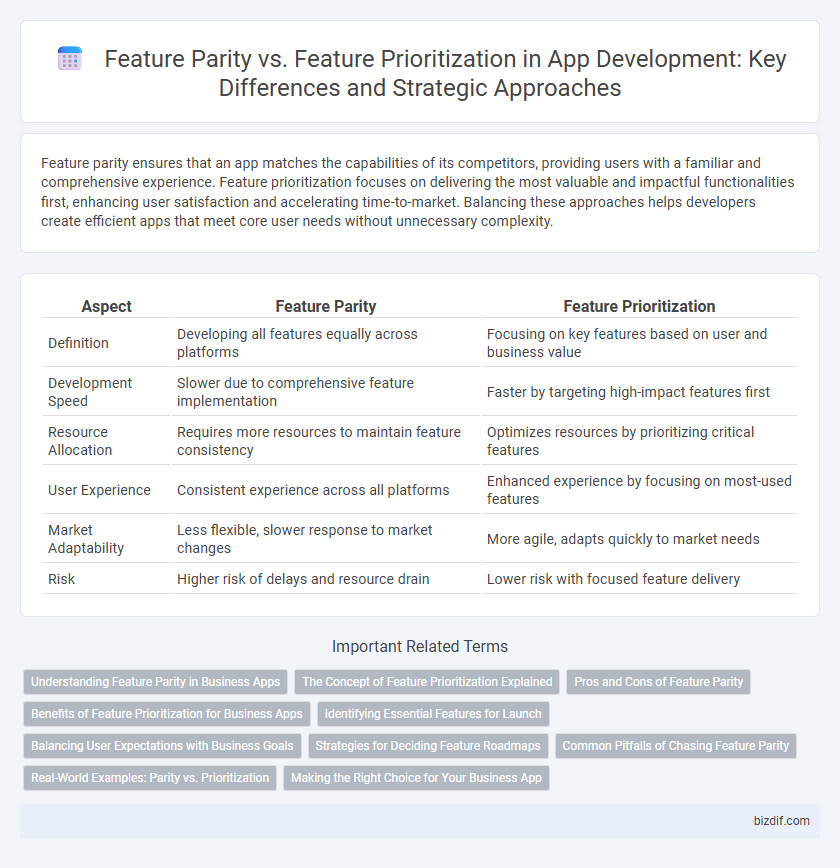Feature parity ensures that an app matches the capabilities of its competitors, providing users with a familiar and comprehensive experience. Feature prioritization focuses on delivering the most valuable and impactful functionalities first, enhancing user satisfaction and accelerating time-to-market. Balancing these approaches helps developers create efficient apps that meet core user needs without unnecessary complexity.
Table of Comparison
| Aspect | Feature Parity | Feature Prioritization |
|---|---|---|
| Definition | Developing all features equally across platforms | Focusing on key features based on user and business value |
| Development Speed | Slower due to comprehensive feature implementation | Faster by targeting high-impact features first |
| Resource Allocation | Requires more resources to maintain feature consistency | Optimizes resources by prioritizing critical features |
| User Experience | Consistent experience across all platforms | Enhanced experience by focusing on most-used features |
| Market Adaptability | Less flexible, slower response to market changes | More agile, adapts quickly to market needs |
| Risk | Higher risk of delays and resource drain | Lower risk with focused feature delivery |
Understanding Feature Parity in Business Apps
Feature parity in business apps ensures that new or updated software versions deliver the same core functionalities as previous releases, maintaining consistent user experience and operational continuity. Achieving feature parity minimizes disruption during app transitions and supports seamless integration with existing business workflows. Prioritizing feature parity enables organizations to uphold reliability while gradually introducing enhancements aligned with strategic goals.
The Concept of Feature Prioritization Explained
Feature prioritization in app development involves systematically ranking features based on user needs, business goals, and technical feasibility to deliver maximum value efficiently. It ensures development teams focus on critical functionalities first, enhancing user experience and speeding up time-to-market. This method contrasts with feature parity, which emphasizes matching competitors' features rather than tailoring to specific project priorities.
Pros and Cons of Feature Parity
Feature parity ensures all platforms offer the same functionalities, promoting a consistent user experience and simplifying support and maintenance processes. However, it can lead to increased development time, resource consumption, and delays in releasing updates compared to prioritizing critical features for faster delivery. Balancing feature parity with strategic feature prioritization is essential to meet user needs while managing project constraints effectively.
Benefits of Feature Prioritization for Business Apps
Feature prioritization in business app development enhances resource allocation by focusing on high-impact functionalities that drive user engagement and operational efficiency. It reduces time-to-market and development costs, enabling faster adaptation to user feedback and market changes. Prioritizing features aligned with core business goals ensures better ROI and improved competitive advantage.
Identifying Essential Features for Launch
Identifying essential features for launch requires balancing feature parity with feature prioritization to ensure the app delivers core functionality without unnecessary complexity. Feature parity involves replicating all key functions from existing platforms to meet user expectations, while feature prioritization focuses on selecting features that provide the highest value and usability from the outset. This approach streamlines development, accelerates time-to-market, and enhances user satisfaction by targeting critical needs during the initial release.
Balancing User Expectations with Business Goals
Feature parity ensures comprehensive functionality matching competitors or previous versions, enhancing user satisfaction by meeting established expectations. Feature prioritization directs development resources toward high-impact features that align with strategic business goals, accelerating time-to-market and maximizing ROI. Balancing these approaches requires analyzing user needs alongside market trends and business objectives to deliver a product that satisfies both customer experience and revenue targets.
Strategies for Deciding Feature Roadmaps
Feature prioritization involves selecting and implementing features that deliver the highest value to users and stakeholders, leveraging data-driven assessments such as user feedback, market trends, and business goals. Feature parity emphasizes maintaining consistency by ensuring new app versions match or exceed the existing functionality, reducing user friction during updates. Balancing these strategies requires aligning technical feasibility, resource availability, and long-term product vision to create a feature roadmap that maximizes impact and user satisfaction.
Common Pitfalls of Chasing Feature Parity
Chasing feature parity often leads to bloated apps with redundant functionalities that dilute user experience and strain development resources. Prioritizing features based on user value and technical feasibility ensures streamlined performance and faster delivery. Ignoring this balance results in delayed launches and increased maintenance costs without guaranteeing user satisfaction.
Real-World Examples: Parity vs. Prioritization
Feature parity ensures that new app versions match existing functionalities, exemplified by WhatsApp maintaining messaging features across platforms to avoid user disruption. Feature prioritization, as seen in TikTok, focuses on launching high-impact capabilities like video editing tools first to drive user engagement and competitive advantage. Balancing parity and prioritization helps developers deliver consistent user experiences while accelerating innovation tailored to market demands.
Making the Right Choice for Your Business App
Feature parity ensures your app matches competitors by delivering comprehensive functionalities, while feature prioritization focuses on implementing the most valuable features first to meet core user needs efficiently. Understanding your target audience and business goals helps determine whether matching competitor features or prioritizing high-impact functions drives better user engagement and ROI. Opting for a balanced strategy can optimize development resources, enhance user satisfaction, and accelerate time-to-market for your business app.
Feature parity vs Feature prioritization Infographic

 bizdif.com
bizdif.com